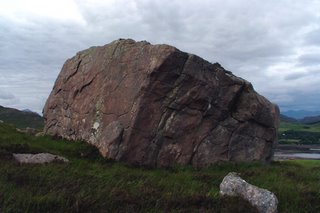
Tony Simpson and Mike Adams were on tour in Scotland and claimed a few new lines at the Applecross boulders. They climbed the wee hanging groove on the downhill face of the Kishorn Stone, at about Font 7b V8 - very hard without a cheat-stone!
Mike Adams also found a solution to the big project on the Russell Boulder. Says Tony:
Mike (after some persuasion that he could pull on) did the undercut project, heading left from the undercuts then back right at around Font 7c+ / V10. I failed to do this due a bad finger injury but was trying the direct undercuts to flake/edge (Lh) small crimp (Rh) then flat edge (Rh) (seemed clean but very hard maybe V11 Font 8a)
There are fine hard problems from the lads and well done to them for persevering and sampling the delights of the North West.